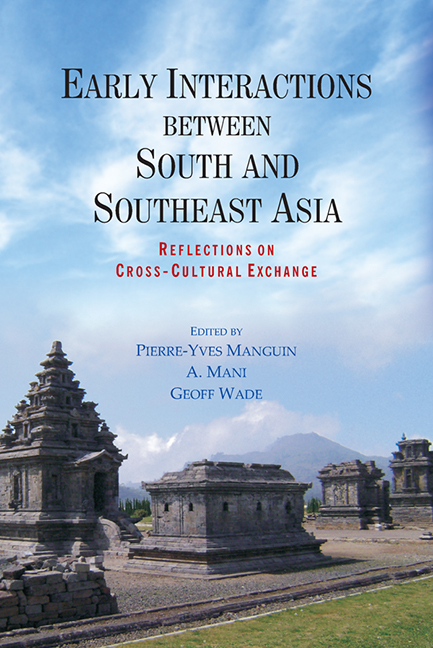Book contents
- Frontmatter
- Contents
- FOREWORD
- Preface
- Introduction
- PART I New Archaeological Evidence from South Asia and Southeast Asia
- PART II Localisation in Southeast Asia
- 11 Tamil Merchants and the Hindu-Buddhist Diaspora in Early Southeast Asia
- 12 The Spread of Sanskrit in Southeast Asia
- 13 The Early Inscriptions of Indonesia and the Problem of the Sanskrit Cosmopolis
- 14 Indian Architecture in the ‘Sanskrit Cosmopolis’: The Temples of the Dieng Plateau
- 15 The Importance of Gupta-period Sculpture in Southeast Asian Art History
- 16 Individuals under the Glaze: Local Transformations of Indianisation in the Decorative Lintels of Angkor
- 17 Early Musical Exchange between India and Southeast Asia
- 18 Buddhism and the Circulation of Ritual in Early Peninsular Southeast Asia
- 19 Early Buddhism in Myanmar: Ye Dhammā Inscriptions from Arakan
- 20 Hindu Deities in Southern Vietnam: Images on Small Archaeological Artefacts
- 21 ‘The Depositing of the Embryo’ – Temple Consecration Rituals in the Hindu Tradition of South and Southeast Asia: A Study of the Textual and Archaeological Evidence
- 22 Localisation of Indian Infl uences as Refl ected in the Laotian Versions of the Ramayana
- 23 Broken Threads: Contested Histories of Brahminism in Cambodia and Thailand and the Construction of Ritual Authority
- LIST OF CONTRIBUTORS
- INDEX
13 - The Early Inscriptions of Indonesia and the Problem of the Sanskrit Cosmopolis
from PART II - Localisation in Southeast Asia
Published online by Cambridge University Press: 21 October 2015
- Frontmatter
- Contents
- FOREWORD
- Preface
- Introduction
- PART I New Archaeological Evidence from South Asia and Southeast Asia
- PART II Localisation in Southeast Asia
- 11 Tamil Merchants and the Hindu-Buddhist Diaspora in Early Southeast Asia
- 12 The Spread of Sanskrit in Southeast Asia
- 13 The Early Inscriptions of Indonesia and the Problem of the Sanskrit Cosmopolis
- 14 Indian Architecture in the ‘Sanskrit Cosmopolis’: The Temples of the Dieng Plateau
- 15 The Importance of Gupta-period Sculpture in Southeast Asian Art History
- 16 Individuals under the Glaze: Local Transformations of Indianisation in the Decorative Lintels of Angkor
- 17 Early Musical Exchange between India and Southeast Asia
- 18 Buddhism and the Circulation of Ritual in Early Peninsular Southeast Asia
- 19 Early Buddhism in Myanmar: Ye Dhammā Inscriptions from Arakan
- 20 Hindu Deities in Southern Vietnam: Images on Small Archaeological Artefacts
- 21 ‘The Depositing of the Embryo’ – Temple Consecration Rituals in the Hindu Tradition of South and Southeast Asia: A Study of the Textual and Archaeological Evidence
- 22 Localisation of Indian Infl uences as Refl ected in the Laotian Versions of the Ramayana
- 23 Broken Threads: Contested Histories of Brahminism in Cambodia and Thailand and the Construction of Ritual Authority
- LIST OF CONTRIBUTORS
- INDEX
Summary
The original aim of this paper, following from my own work in early medieval Indian history, was to explore the role that South Asian political ideas and practices played in the transformation of early Southeast Asian societies. Partly inspired by Hermann Kulke's work on state-formation, partly by Sheldon Pollock's recent theory of the ‘Sanskrit cosmopolis’, both of which, in different ways, have argued for strong continuities in the cultural and social development of South and Southeast Asia in early medieval times, I sought to correlate the literary, ideological and administrative aspects of early Indonesian inscriptions against their wider social contexts. The research, however, threw up some major analytical problems which have proved very instructive, the most pertinent of which was the difficulty of linking language practice and ideologies on the one hand and state ‘structures’ and social formations on the other. My findings, which seem clearly as relevant for South as for Southeast Asian history, suggest that the relations between ‘cultural practices’ and state structures are highly complex and shifting. While this may seem like a point of almost staggering banality, I hope to show more precisely how such an analytical awareness may add a new perspective on highly-touted theories of linguistic and cultural ‘cosmopolitanism’ inspired by Pollock's work. Before turning to the evidence, this essay will place the discussion within an analytical environment through a brief survey of major approaches to understanding the role of South Asian culture in Southeast Asian history.
SANSKRIT AND STATE FORMATION IN SOUTHEAST ASIA: FROM EMPIRE TO COSMOPOLIS
The historiography of South and Southeast Asian interactions, and indeed the conceptualization of the conference itself, ‘Early Indian influences in Southeast Asia’, has a well-established pedigree. Since at least the end of the nineteenth century, but more clearly since the rise of nationalist historiography in India, the topic has been of great interest to both scholars of South and Southeast Asian history. While there is no space here for a complete review of this work, it will be useful to present a brief account of the major approaches in order to situate my own concerns. Earlier generations of nationalist scholarship in India forwarded the idea of Hindu colonies in the Far East, of a vast cultural ‘empire’ known as ‘Greater India’.
- Type
- Chapter
- Information
- Early Interactions between South and Southeast AsiaReflections on Cross-Cultural Exchange, pp. 277 - 298Publisher: ISEAS–Yusof Ishak InstitutePrint publication year: 2011

